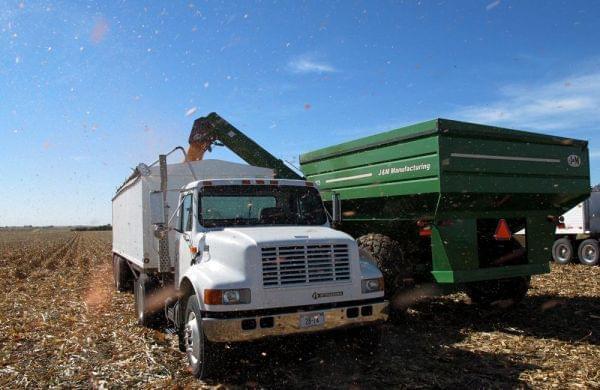Farm Income Rising, But Not Everywhere

In central Nebraska, a combine unloads harvested corn into a truck. For many farmers, the cost of growing a field of corn remains higher than the amount they can make from it. Grant Gerlock/Harvest Public Media
The farm economy is showing some stability, the U.S. Department of Agriculture says, but the upswing doesn’t extend to all agricultural sectors.
Over the last three years, farm earnings have plummeted, eliciting concerns that the farm economy could tumble toward another farm crisis like the 1980s. For 2017, the USDA expects net farm income to rebound by a modest 3 percent nationwide, to $63 billion.
The gains largely come from higher prices and export demand for dairy, beef, pork and poultry. Yet, income for crop farmers continues to lag thanks to an oversupply of grain, lower sales and lower government payouts, according to USDA economist Carrie Litkowski.
The USDA says in its report, released Wednesday, that it expects to pay out $2 billion less because the main programs are based on crop prices and yields; prices have been low, but yields have been abundant.

The Northeast ag economy is looking up thanks to dairy. The Southern Plains are doing better with help from cotton and cattle. However, the Northern Plains and Midwest are held back by low prices for corn and soybeans.
Different regions of the U.S. are also faring better based on their dominant crop due to price differences. For example, income in the southern Plains is rebounding on the strength of cotton and cattle, and dairy has been a boon in the Northeast.
But earnings in the Northern Plains and Midwest will likely continue to decline, according to the USDA, because of lackluster corn and soybean prices.
When farmers meet with their bankers this winter, there will be a lot of discussion about how to further cut costs on things like seed, fertilizer and fuel, Farm Credit Services of America's Chief Credit Officer Tim Koch says.
“As we talk to producers, we focus on what their cost of production is and get them in a position where they can be competitive and generate profitable operations at these current commodity price levels,” Koch says.
If farmers find themselves in a financial pickle, they still have valuable land, but that doesn’t help them turn a profit from one year to the next. In recent years, a little more than 50 percent of farm operations lost money, the USDA says.
While many farm businesses are losing money, the USDA says median income for farm households has remained stable and is higher than the U.S. overall. That's because many farm families rely on jobs outside of farming for their livelihood.
Follow Grant on Twitter: @ggerlock
Links
- Illinois Congressman Learns About Agriculture Research At University of Illinois
- U of I Researcher: Proposed Agriculture Budget Cuts Would Hurt Research On Climate and Crops
- President Trump Signs Executive Order on Agriculture
- Cover Crops Can Help The Environment, But Can Farmers Afford To Plant Them?
- Low Prices Hitting Midwest Farmers; Angry Parents And Youth Sports; Armadillos Invade Illinois
- Another Rough Income Year for Grain Farmers
